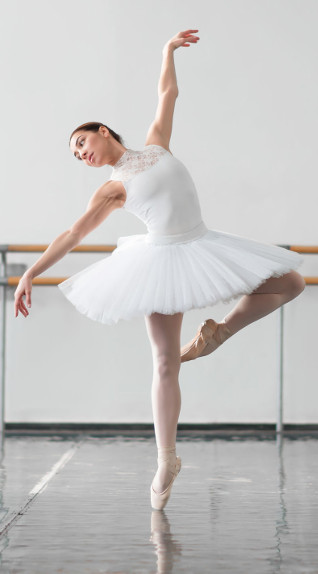Ballet |
|
Introduction Into Ballet |
|
| Ballet is arguably the hardest form of dance to master, requiring a lot
of dedication and focus. Though it may not be the most popular dance
technique among dancer’s it is notably the most recognisable form of
dance due to the unique movement of the routine as well as the tutus. Ballet is usually the first dance technique that is introduced to young dancerswhich may come to a surprise to many who think “why start off with such a difficult style of dance” this is because ballet is so difficult and requires the dancer to develop and strengthen their body before they can progress to point shoes through years of dedication because of this ballet harder to master the older you start hence. The difficulty of the dance and the disadvantages dancer who start late face is the reasons why it’s not the most popular among dances as many dancers start late in life but is the most respected. There are various different styles to ballet. |
|
Classical |
|
| Classical ballet or traditional ballet has been around since the 16th
century though back then it was simply referred to as ballet. Since its
introduction into the dancing community various different styles have
emerged from different countries each with their own take on classical
ballet. The most notable of these styles include French ballet, Russian
ballet, English ballet and Italian ballet. The royal academy of dance method also referred to as the English style of ballet was developed by a diverse group of dancers merging various classical ballet styles into one unique dance technique. A renowned and universally recognised production of classical ballet is the nutcracker. |
|
Romantic |
|
| Romantic ballet gets its name from the era where this style of ballet
became extremely popular. The romantic era this spanned early to mid
19th century. Romantic ballet redefined ballet and introduced elements, themes and movements that are now synonymous with ballet today. Pointe work, tutus and the dominance of female dancers in the productions all come from romantic ballet. Romantic ballet productions attempted to convert intense emotions into fluid movements. Another popular theme of romantic ballet is the inclusion of the supernatural with the plot seeing the lead dancer portrayed as some kind of spirit. |
|
Neoclassical |
|
| Neoclassical ballet has an increased emphasis on the movement; in fact
neoclassical ballet is solely about the movement as the productions
often lack a clear plot, set design/ scenery. Neoclassical is more of a
dance interpretation of the music score with a focus on expression
rather than an attempt to tell a story through mime and movement. This
results in neoclassical dance composers having more freedom when
choosing the music as the score no longer has to match the tone of the
narrative. |
|
Contemporary |
|
| Contemporary ballet shares many similarities with Neoclassical that it can be hard to differentiate between the two. Contemporary ballet is essentially contemporary dance using ballet techniques hence the name and includes contemporary dance techniques such as floor work and the turn-in of the legs. |
|
